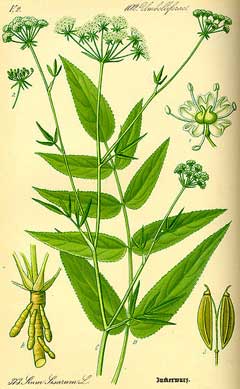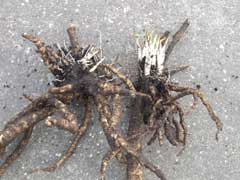 |
|
http://commons.wikimedia.org/wiki/File:Illustration_Sium_sisarum0.jpg |
 |
| © Jaap Uilhoorn |
Translate this page:
Summary
Physical Characteristics

 Sium sisarum is a PERENNIAL growing to 1 m (3ft 3in) by 0.4 m (1ft 4in).
Sium sisarum is a PERENNIAL growing to 1 m (3ft 3in) by 0.4 m (1ft 4in).
See above for USDA hardiness. It is hardy to UK zone 6 and is not frost tender. It is in leaf from March to November, in flower in July, and the seeds ripen in September. The species is hermaphrodite (has both male and female organs) and is pollinated by Insects. The plant is self-fertile.
Suitable for: light (sandy) and medium (loamy) soils. Suitable pH: mildly acid, neutral and basic (mildly alkaline) soils. It can grow in semi-shade (light woodland) or no shade. It prefers moist soil.
UK Hardiness Map
US Hardiness Map
Synonyms
Plant Habitats
Cultivated Beds;
Edible Uses
Edible Parts: Root
Edible Uses: Coffee
Root - raw or cooked[2, 4, 14, 33]. Firm, sweet and floury[27] but with a small woody core[160, K]. The roots have a very acceptable taste raw, that is somewhat like a cross between carrots and parsnip but with a nutty flavour. They can also be boiled, baked or added to soups etc[183, K]. The roasted root has been used as a coffee substitute[46, 61, 183].
References More on Edible Uses
Medicinal Uses
Plants For A Future can not take any responsibility for any adverse effects from the use of plants. Always seek advice from a professional before using a plant medicinally.
Appetizer
None known
References More on Medicinal Uses
The Bookshop: Edible Plant Books
Our Latest books on Perennial Plants For Food Forests and Permaculture Gardens in paperback or digital formats.

Edible Tropical Plants
Food Forest Plants for Hotter Conditions: 250+ Plants For Tropical Food Forests & Permaculture Gardens.
More

Edible Temperate Plants
Plants for Your Food Forest: 500 Plants for Temperate Food Forests & Permaculture Gardens.
More

More Books
PFAF have eight books available in paperback and digital formats. Browse the shop for more information.
Shop Now
Other Uses
References More on Other Uses
Cultivation details
Prefers a light, rich, moisture retentive soil in full sun[1, 33, 37]. Requires an abundance of moisture in the growing season or the roots will be tough[27, 37]. Plants are tolerant of some shade[244]. Plants seem to be resistant to all insects and diseases[160]. Skirret was at one time often grown for its edible root but has fallen into virtual disuse[2, 50, 61]. This is a shame since the root is very tasty, easy to grow and relatively productive[K]. The form S. sisarum sisarum should be used, its root is fleshy and succulent, S. sisarum lancifolium. (Bieb.) Thell. is sometimes offered but is unlikely to produce roots of culinary quality[200]. For polyculture design as well as the above-ground architecture (form - tree, shrub etc. and size shown above) information on the habit and root pattern is also useful and given here if available. The plant growth habit is a clumper with limited spread [1-2]. The root pattern is tuberous with swollen potato-like roots [1-2].
References Carbon Farming Information and Carbon Sequestration Information
Temperature Converter
Type a value in the Celsius field to convert the value to Fahrenheit:
Fahrenheit:
The PFAF Bookshop
Plants For A Future have a number of books available in paperback and digital form. Book titles include Edible Plants, Edible Perennials, Edible Trees,Edible Shrubs, Woodland Gardening, and Temperate Food Forest Plants. Our new book is Food Forest Plants For Hotter Conditions (Tropical and Sub-Tropical).
Shop Now
Plant Propagation
Seed - sow late winter to early spring in a cold frame[1, 33]. It can be slow to germinate. Prick out the seedlings into individual pots when they are large enough to handle and plant them out in the summer if they are large enough. Otherwise, grow them on in a cold frame for their first winter and plant them out in the following spring. The seed is best sown in early April in situ[1, 33]. Division in early spring just before new growth begins. Use the side roots to produce new plants[1]. Larger divisions can be planted out direct into their permanent positions. We have found it best to pot up the smaller divisions and grow them on in a lightly shaded position in a cold frame, planting them out once they are well established in the summer.
Other Names
If available other names are mentioned here
Native Range
TEMPERATE ASIA: Armenia, Azerbaijan, Ciscaucasia, Dagestan, Iraq, Kazakhstan, Kyrgyzstan, Russian Federation, Russian Federation-Ciscaucasia, Tajikistan, Turkey, Turkmenistan,Iran. EUROPE: Hungary, Russian Federation-European part, European part (south), Moldova, Ukraine (incl. Krym), Bulgaria, Romania,
Weed Potential
Right plant wrong place. We are currently updating this section.
Please note that a plant may be invasive in one area but may not in your area so it's worth checking.
Conservation Status
IUCN Red List of Threatened Plants Status :

Growth: S = slow M = medium F = fast. Soil: L = light (sandy) M = medium H = heavy (clay). pH: A = acid N = neutral B = basic (alkaline). Shade: F = full shade S = semi-shade N = no shade. Moisture: D = dry M = Moist We = wet Wa = water.
Now available:
Food Forest Plants for Mediterranean Conditions
350+ Perennial Plants For Mediterranean and Drier Food Forests and Permaculture Gardens.
[Paperback and eBook]
This is the third in Plants For A Future's series of plant guides for food forests tailored to
specific climate zones. Following volumes on temperate and tropical ecosystems, this book focuses
on species suited to Mediterranean conditions—regions with hot, dry summers and cool, wet winters,
often facing the added challenge of climate change.
Read More
Expert comment
Author
L.
Botanical References
50200
Links / References
For a list of references used on this page please go here
Readers comment
© 2010, Plants For A Future. Plants For A Future is a charitable company limited by guarantee, registered in England and Wales. Charity No. 1057719, Company No. 3204567.